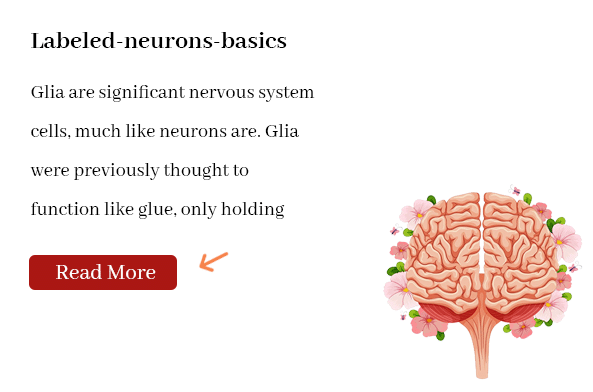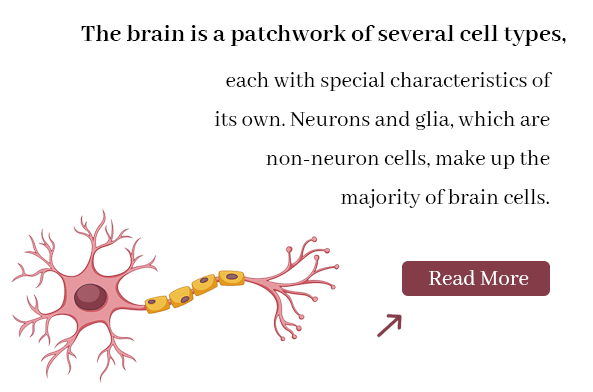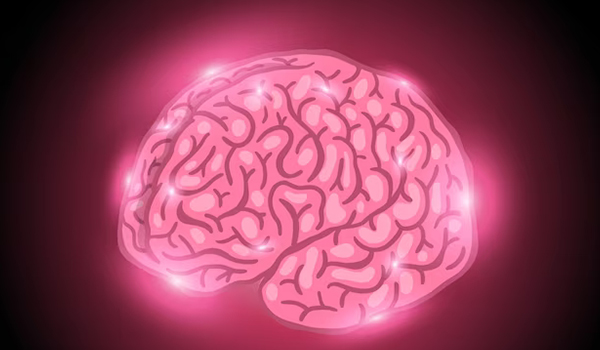The brain is a patchwork of several cell types, each with special characteristics of its own. Neurons and glia, which are non-neuron cells, make up the majority of brain cells.
An adult human brain typically has 100 billion neurons and an equal or greater number of glia.While neurons are the most well-known brain cells, glial cells are also essential for healthy brain function.
Neurons
Most likely, neurons come to mind when you think about the brain. The brain’s neurons are the cells that transmit and receive chemical and electrical signals.
They serve as the building blocks of your brain and carry messages from them to other neurons, muscles, and other tissues.They allow you to think, feel, move, and comprehend the world around you.
Three main components make up a neuron: the soma, or cell body; branching dendrites, which receive messages from other neurons; and the axon, which uses the axon terminal to deliver signals to neighboring neurons.
Electric and chemical impulses travel over a tiny gap known as the synapse from the axon of one neuron to the dendrites of another neuron when a neuron fires an action potential.

Labeled-neurons-basics
Glia
Glia are significant nervous system cells, much like neurons are. Glia were previously thought to function like glue, only holding neurons in place.
The word “glia” means “glue” in Latin. Glial cells, however, are more than just brain glue, as we now understand. In actuality, glia are essential to the normal operation of neurons and actively take part in brain transmission.
Glial cells are not inert just because they are unable to produce action potentials to convey signals, unlike neurons. Glia use chemical signals to communicate with neurons and with each other. They can even react to many of the same substances as neurons, including ions and neurotransmitters.
This implies that glia have the ability to listen in on neurons to enhance the signals that are exchanged between them. The brain contains a wide variety of glial cell types.
Three significant glial cell types are as follows:
Oligodendrocytes:
The axons of neurons are encircled by a unique kind of glial cell called an oligodendrocyte, which forms the myelin sheath.Oligodendrocytes help neurons transmit electrical signals over great distances and at a high speed by insulating the axon, much like insulation does for an electrical wire.
microglia-basics-cartoonThe immune cells that make up the central nervous system are called microglia.They are continually in motion within the brain, interacting with other glia. Microglia in an adult brain in good health are continuously scanning their surroundings for indications of problems.
For instance, neurons that are killed or injured by an illness or disease will emit chemical warning signals. When other microglia in the vicinity detect these signals, they become aware of possible danger.
As a result, the nearby microglia gather in the hazardous region and start to clear the mess.
This shields the brain from chronic inflammation and stops accumulation of debris from spreading throughout the brain. Microglia return to their resting state and continue to scout the brain after the threat has passed.
Astrocytes are star-shaped cells that envelop and facilitate the operation of neurons.Astrocytes mainly help regulate the brain environment.
Astrocytes help neurons communicate with each other by moving chemicals from one neuron to another. Even though microglia are the brain’s main immune cells, astrocytes can support microglia in times of need.
Research Highlight
Glial cells have been found to have new roles in illness recently. Glia normally support and shield neurons, but when they don’t work properly, they can do a lot of harm.
According to research on animals, glia-induced inflammation is linked to a variety of illnesses, including multiple sclerosis, Parkinson’s disease, and Alzheimer’s disease.Because it enables researchers to study human diseases in animal models, this kind of research is crucial. We will be able to treat these illnesses using the knowledge we gain about glia as time goes on.


